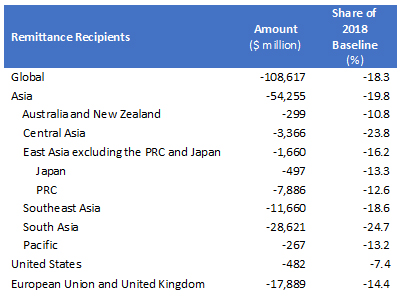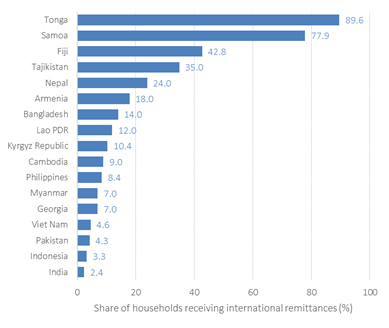
The coronavirus disease (COVID-19) pandemic has devastated economies worldwide, slashing jobs and incomes. The Asian Development Bank (ADB) (2020a) estimates that employment in Asia and the Pacific will fall by as much as 167 million jobs in 2020 should containment measures last 6 months from when the outbreak first intensified in the respective countries. In turn, wage incomes in the region are projected to fall from $359 billion to $550 billion.
Migrant workers, many of who have limited job security and access to social assistances, are among the hardest hit groups as workplace closures and border control restrictions are being put in place to abate further outbreaks. The crucial remittances they send home to their families are expected to decline dramatically.
Asian migrants’ jobs at risk
Asia and the Pacific accounted for 33% (91 million) of the 272 million migrant workers worldwide in 2019. The major destination regions for Asian migrants included Asia (35%), the Middle East (27%), Europe including of the Russian Federation (19%), and North America (18%). COVID-19 has hit all of them hard, with economic output in these economies projected to contract by between 6.7% and 10.2% in 2020.
The overall economic conditions of the host countries and their sectoral affiliations determine the impact, with severe losses of migrant jobs reported in the retail trade, manufacturing, hospitality and recreation, and accommodation and food service sectors. Workers have been laid off and, in many cases, stranded in host economies as strict quarantines have been imposed, borders closed, and air travel halted. Worse still, departures of new migrant workers from Asia have been put off until further notice.
Remittance flows to developing Asia to plunge amid the pandemic
The pandemic is taking a heavy toll on remittance flows to developing Asian economies. Official central bank data on remittance inflows show significant declines, although their magnitude and consistency vary across countries. Some altruistic migrant workers may still be able to send money home to their families in extremely difficult situations, but the prevailing weak economic forecasts suggest remittances will plunge.
Using a bilateral labor migration model, GMig2, and the Global Trade Analysis Project (GTAP) database, we analyzed COVID-19’s effect on remittance inflows. Our analysis assumes that the pandemic has reduced gross domestic product (GDP) growth through country-specific declines in tourist arrivals, domestic consumption, investment, and production, and increases in trade costs, as reported in a recent ADB assessment. The outbreak has also undermined oil prices and oil demand, which has hit employment and wage differentials between home and host countries. These shocks hurt migrant employment and migrants’ ability to send remittances.
In the analysis, if outbreak control and normalization take about a year—with the pandemic effects on the economy halving in the last quarter of the year as containment efforts and re-opening take effect—global remittances are expected to decline by $108.6 billion in 2020, equivalent to 18.3% of the global baseline remittances in 2018 (Table 1). Remittance receipts in Asia will fall by $54.3 billion, equivalent to 19.8% of the baseline remittances. By subregion, remittances in South Asia will fall most, by $28.6 billion (24.7% of the 2018 baseline). Remittances to Central Asia follow (declining by $3.4 billion, 23.8%), then Southeast Asia ($11.7 billion, 18.6%) and East Asia excluding the People’s Republic of China and Japan (1.7 billion, 16.2%). Remittances to the Pacific will also fall ($267 million, 13.2%).
Table 1: Impacts on Global Remittance Inflows

PRC = People’s Republic of China.
Note: The data presented for East Asia do not include the PRC or Japan.
Source: Asian Development Bank estimates.
Remittance-dependent households at risk of falling into poverty
International remittance inflows are critical in Asia’s efforts to uplift the lives and welfare of poor people in the region. In a cross-country study involving 10 migrant-sending countries in Asia, Yoshino, Taghizadeh-Hesary, and Otsuka (2017) estimate that a 1 percentage point increase in remittance inflows from overseas as a share of GDP is associated with a 22.6% reduction in the poverty-gap ratio and a 16% decline in the poverty-severity ratio.
Families in migrant-sending households use remittances to buy essential items and services, such as food, clothing, shelter, health, and education. Indeed, hundreds of thousands of households in countries of origin depend on income from remittances. Nearly 90% of households in Tonga, 80% in Samoa, and more than 40% in Fiji are reported to receive some amount of remittances from overseas (Figure 1).
Figure 1: Share of Households Receiving International Remittances

Lao PDR = Lao People’s Democratic Republic.
Sources: ADB compilation using data from household surveys, various years.
An unexpected reduction or suspension of these remittances can leave recipients particularly vulnerable. In the Kyrgyz Republic, for example, remittances constitute 75% of recipient households’ income on average (Gao, Kikkawa, and Kang 2020). Concerns are even greater for households comprising older people or those with no additional income earners. In the Philippines, over 21% of senior citizens receive remittances (Philippine Statistics Authority 2020). Many existing government emergency social protection measures are linked to employment (e.g., unemployment benefits and minimum wage guarantee programs), and these, by design, will not reach hard-hit remittance recipient households.
Recommended policy actions
International migration, the cross-border mobility of workforces, and flows of worker remittances are essential features of today’s globalized economy. As such, the COVID-19 pandemic has undermined the social and employment status of migrant workers and their families, and host and source countries are encouraged to provide them with effective support.
Authorities in these countries can take several measures to provide assistance. They are encouraged to:
- extend temporary health and social services to assist stranded and returned migrants;
- expand social protection coverage to low-income remittance recipient households who may fall back into the poverty trap;
- design comprehensive national migration policy frameworks that encompass immigration, health, and labor policies to support migrant workers and improve their rights and welfare; and
- ensure the continuity of remittance services, including through the use of digital and online platforms to better serve migrants and their families.
This blog is based on ADB Brief 148 (ADB 2020b).
_____
References:
Asian Development Bank (ADB). 2020a. An Updated Assessment of the Economic Impact of COVID-19. ADB Briefs No. 133. Manila: ADB.
ADB. 2020b. COVID-19 Impact on International Migration, Remittances, and Recipient Households in Developing Asia. ADB Briefs No. 148. Manila: ADB.
Gao, X., A. Kikkawa, and J. W. Kang. 2020. Evaluating the Impact of Remittances on Human Capital Investment in the Kyrgyz Republic. Draft.
Philippine Statistics Authority. 2020. Domestic Remittances are Just as Important as International Remittances (Results from the 2018 National Migration Survey). Press release.
Yoshino, N., F. Taghizadeh-Hesary, and M. Otsuka. 2017. International Remittances and Poverty Reduction: Evidence from Asian Developing Countries. ADBI Working Paper No. 759. Tokyo: Asian Development Bank Institute.










Comments are closed.